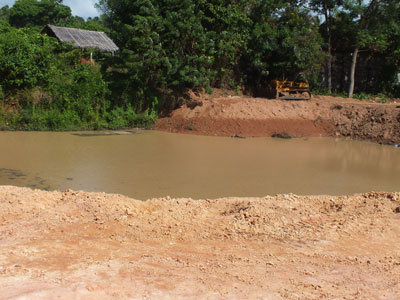Construction industry discusses possibility of importing sand
View(s):Several discussions are ongoing on the possibility of importing river sand as the demand for sand, a limited resource is on the rise, experts in the construction sector say.

River-side mining
Owing to the vast development in the country, sand for construction is a major requirement and the demand for this is increasing at an alarming rate, they said.
Current construction sand demand in the country is calculated at 23 million cubes. Sand construction is sourced through rivers, land-based sand, dredged sand and manufactured sand.
The current situation of river sand mining has increased around the country and this indirectly has led to illegal mining activities, analysts noted. The increased demand has made the sand suppliers resort to over exploitation of river beds and digging the river banks.
Experts said that the lowering of riverbeds has caused intrusion of seawater upstream to the rivers. In fact on Kelani River reportedly seawater has reached up to Hanwella. The damage to the environment at many locations is considered irreversible.
“Relevant government agencies have to implement more conditions and regulations when issuing river sand mining licenses,” P. D. Maha Arachchi, Geologist GSMB Technical Services Pvt Ltd said at a recent seminar on the supply of sand for construction work organised by the Chamber of Construction Industry Sri Lanka.
The government is now forced to impose many restrictions on the mining and transportation of sand which resulted in shortages in sand which led to prices increasing up to Rs.16,000 per sand cube.
Mr. Maha Arachchi said that currently most sand mining sites around the country are applying the artisanal mining method which deals in formal or informal operations with predominantly simplified forms of exploration, extraction, processing and transportation.
The maximum extraction quantity given by GSMB for a license is 210 cubes per month. In some specific cases the extraction quantity deviates when it deals with mechanised mining. Mr. Maha Arachchi said that most of the river sand mining areas in the country are not operating with stipulated feasibility studies and recommendations. “Operating sites without these recommendations will generate an irreversible impact to the river and surrounding environments.” He added that this is why the construction industry is discussing possibility of importing sand.
He said that negative impacts range from riverbed deepening, lowering of regional water table by deepening of river bed, riverbank erosion, disturbances to aquatic resources, salinity intrusions and loss of aesthetic value of streams.
He added that it is now prudent to look at importing river sand.
Explaining on the existing weaknesses, drawbacks and issues in sourcing sand, K.V. Jagath, an engineer, presenting on the “Regulation of Sand Supply and the Role of the Geological Survey and Mines Bureau [GSMB]” noted that those who need to purchase sand must depend on the mining licence holder. He said that there is a lot of time required to obtain a licence and that there are many issues with forged transport licences transporting sand from one point to another. “There is no online checking of the legality of issued transport licences and no proper enforcement mechanisms either by the GSMB or the police on illegal activities.”
At this seminar alternatives for sand usage were also discussed.
Prof. Ranjith Dissanayake, Senior Professor Department of Civil Engineering, University of Peradeniya presenting on minimising sand use, noted that alternatives to sand usage range from methods such as secondary material usage, using local materials, changing attitude towards new materials and building green. Prof. S.M.A. Nanayakkara, University of Moratuwa presenting on the alternatives for sand noted that offshore sand is a suitable alternative for river sand. “Offshore sand should be processed by sieving and washing to remove large shells and chlorides. Since the offshore sand particles are rounded and smooth, workability of the concrete with this sand improves.”


